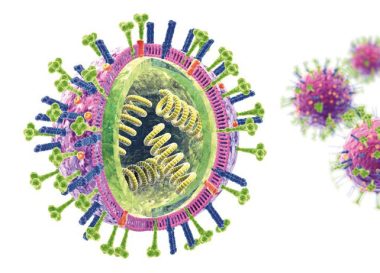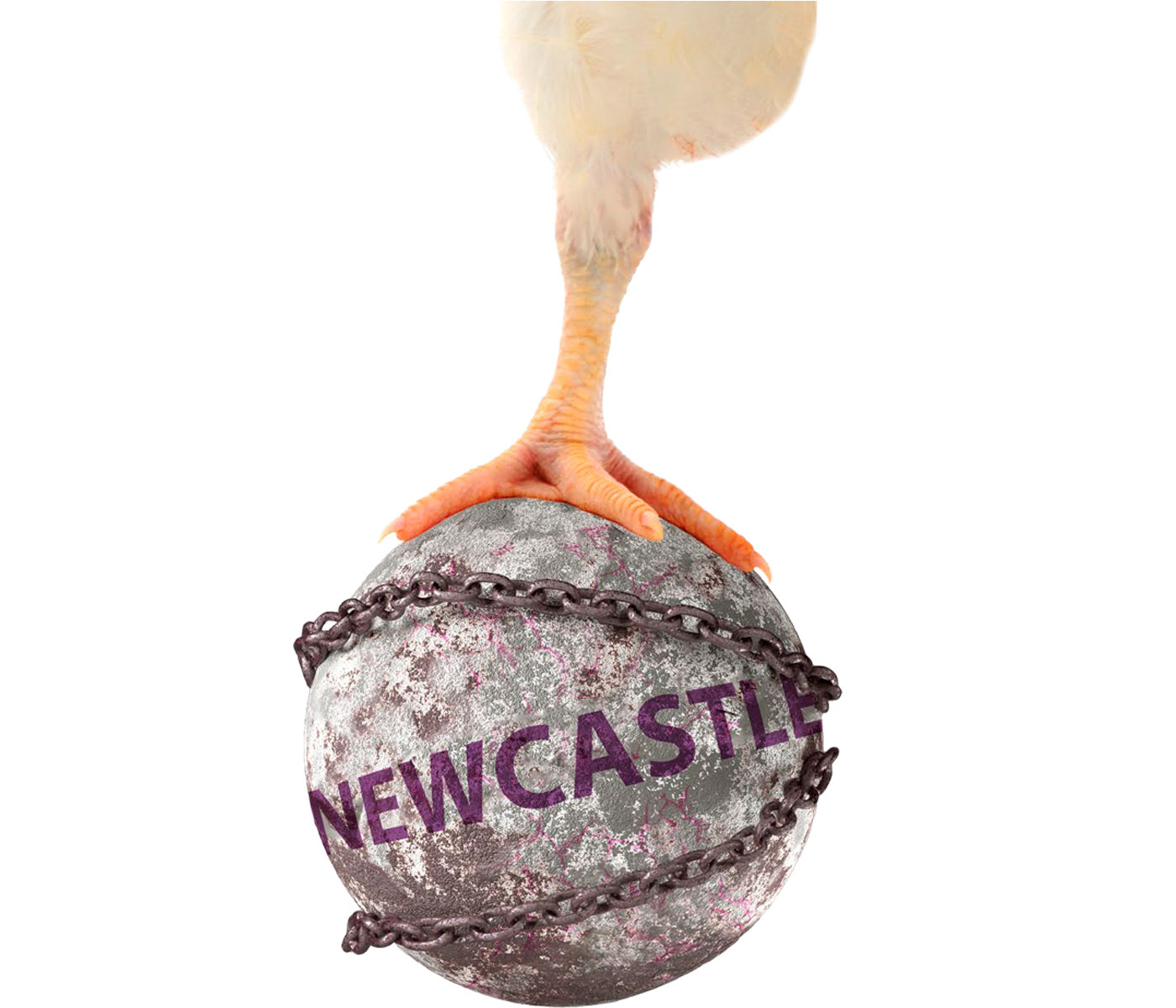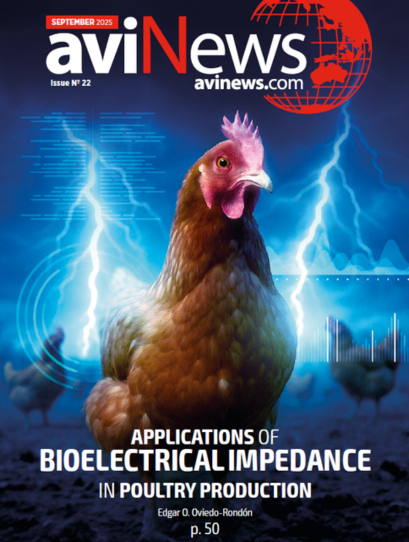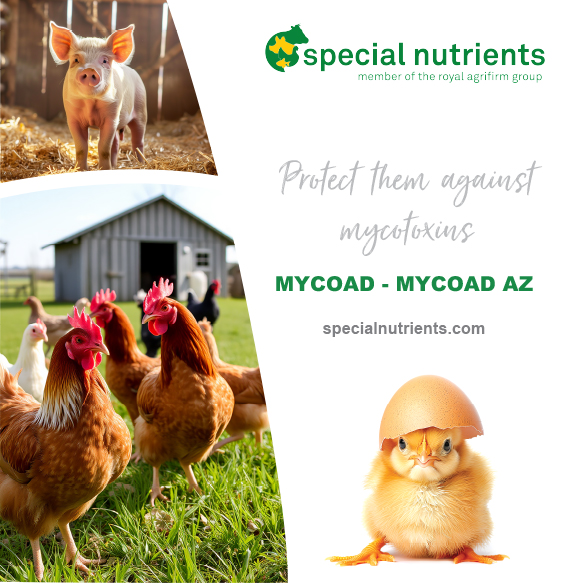Newcastle disease (ND) is a highly contagious viral disease that affects commercial poultry, domestic and backyard poultry. Caused by the Newcastle disease virus that can cause significant losses in poultry, which in many cases include chickens and hens, but is also known to affect turkeys, ducks, geese and other birds.
In this second part of the article we will continue to learn more about Newcastle disease virus (NDV) and review what prevention, biosecurity and vaccination measures are in place to control this disease that continues to be a problem in many countries around the world.
HOSTS AND VIRAL RESERVOIRS
The virus is known to have a wide host range, with at least 236 species classified in 27 of 50 orders of birds being susceptible (Kaleta EF and C Baldauf. 1988).
- However, the greatest impact of the disease is on domestic poultry, chickens and hens, both technified and backyard, where the disease can cause large economic losses (Miller and Koch, 2020).
The four panzootics described by Dr. Alexander since 1926, when NDV was first recognized, have involved wild pigeons and imported psittacines in the spread of the virus throughout the world (Figure 2).
- However, outbreaks of ND in cormorants in the USA in 2010 and in Chile in 2007, caused by genotype V mesogenic type virus (Diel et al., 2012; Moreno et al., 2009), have been of concern to poultry producers in those countries.
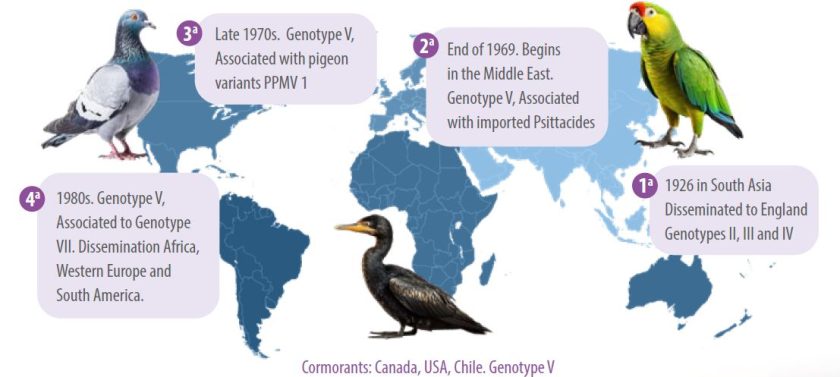
These findings highlight the importance that not only psittacine and columbiform birds represent in the spread of pathogenic strains of the virus, but also wild birds in general, especially in those countries free of vvVEN (Figure 2).
On the other hand, even though it is known that wild birds generally harbor lentogenic strains, while outbreaks in domestic birds are caused by meso or velogenic strains (Sahoo et al., 2022), historical records and phylogenetic sequence analyses available in the gene bank also suggest that:
- Virulent viruses currently circulating may have emerged from low virulence viruses of the 1920s-1940s, by mutational changes at the fusion protein cleavage site (Afonso CL, 2021).

Although, multiple studies have attributed to wild birds the responsibility for outbreaks, considering them natural reservoirs of the virus, the analysis of the casuistry of the Laboratory of Avian Pathology (LPA) of the Faculty of Veterinary Medicine of the UNMSM, and recent studies carried out with isolates obtained during almost 20 years, have shown that:
- Fighting birds largely outnumber the occurrence of ND outbreaks over time, showing that they carry the greatest diversity of genotypes, with only virulent viruses of genotypes XII and VII being detected in them.
- So in Peru, they constitute the main source of contamination and reservoir of the virus.
The route of transmission of the virus is horizontal, birds are infected by inhalation or ingestion of aerosols or contaminated material;
- The infected birds eliminate the virus in nasal and ocular secretions; on the other hand, besides the fact that the ND virus replicates in the respiratory tract, it also replicates in the intestine, being transmitted through the feces (Alexander, 1998).
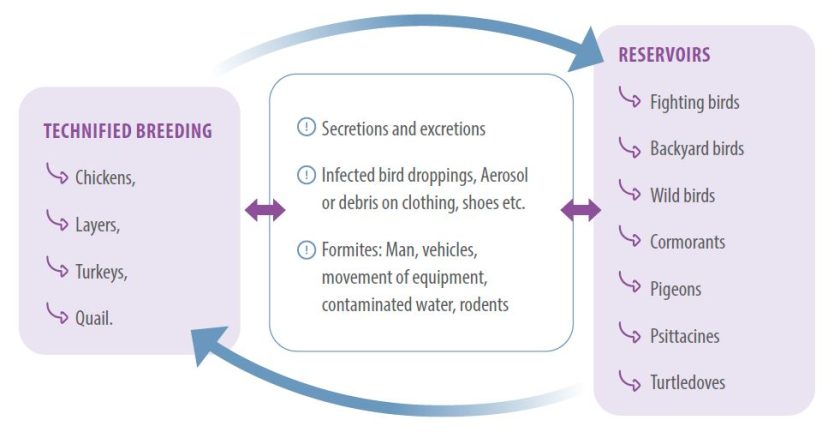
CLINICAL SIGNS
The incubation period varies from 2 to 15 days, with an average of 5 to 6 days.
- Lentogenic strains cause mild respiratory infection (postvaccination reaction);
- Velogenic viscerotropic strains, which are the main strains circulating in the world, cause severe depression, edema around the eyes, swelling of the head and greenish diarrhea (Figure 4 and 5).
Neurological signs include torticollis, opisthotonos, leg and wing paralysis; In birds in production, decrease or cessation of laying and alterations in the external and internal quality of the eggs, whether discolored to white, (Miller and Koch, 2020; Koffi X et al, 2021) the latter even in birds with multiple vaccinations (Figure 6 and 7).
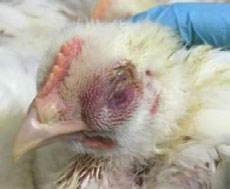
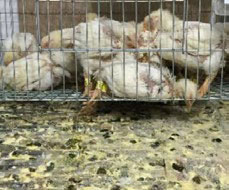
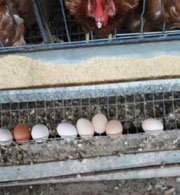

The birds without immune protection infected with virulent strains; They show severe depression from the second day post infection, being able to reach 100% mortality at the third or fourth day post infection (Figure 8 and 9).


Macroscopic lesions
The vvVEN cause hemorrhagic lesions in the lymphoid aggregates of the gastrointestinal tract: eyelid mucosa, cecal tonsils, Peyer’s plaques proventriculus and fabricius bursa (Figures 10, 11 and 12).
In adult birds in production, egg peritonitis, atrophy of ovarian follicles and degeneration of the oviduct can be observed;
- In well protected birds with many vaccines there is no mortality and lesions may go unnoticed (Miller and Koch, 2020; Koffi X et al, 2021 ).

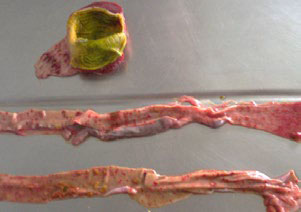

DIAGNOSTIC
The main diagnostic tools include:
- Viral isolation, serological tests (hemagglutination and hemagglutination inhibition, ELISA).
- Molecular tests: Conventional PCR, real-time PCR and F-gene or whole genome sequencing.
Comparing diagnostic methods for ND:
Viral isolation is the standard strategy considered as the “Gold standard” test for virus diagnosis, being universally used since the early 1960’s (Alexander DJ. 2003).
- It is performed by inoculation of Specific Pathogens Free (SPF) embryonated eggs,
- however, the allantoic sac inoculation route allows the virus to be isolated from non-SPF commercial embryonated eggs as well.

Rapid diagnosis is necessary to implement immediate control measures, an RT-PCR test using highly conserved primers such as the M and L protein genes can detect all viral genotypes allowing immediate results (Hoffmann B et al. 2009).
- To identify virulence, sequences including the cleavage site of the gene encoding the Fusion protein are required.
- To identify the genotype, sequencing of the complete F gene is required, which in turn provides us with the virulence identification;
- This means that the genomic analysis that should not be missed when you have positive isolates is the analysis of the complete fusion gene.
Sequencing and phylogenetic analysis have become the method of choice for characterizing circulating strains in the field, showing genetic diversity and a constant emergence of new genotypes in the world (Dimitrov et al., 2019).
BIOSECURITY
- The main objective is to prevent the introduction of the virus to the farm, to avoid the exposure of the birds to the pathogenic virus.
- Most of the time isolation is not possible, therefore, strict biosecurity protocols must be implemented, including:
- Control of people, vehicles, rodent/ fly pests and waste, at all levels of the production process. These measures should also be applied to backyard poultry farms.
People and vehicles are the main carriers of the virus inside the farm, therefore it is essential to follow the protocols of cleaning and disinfection, raising awareness of personnel, and providing the necessary exclusive clothing and materials to comply with basic biosecurity measures such as: bathing, change of clothes, shoes, etc.
On the other hand, the farm infrastructure should contemplate the protection of the shed, equipment, water and feed to avoid access of wild birds, mainly columbiformes that could be carriers of the pigeon-type virus.
VACCINATION
Vaccination is the second most important prevention tool, it does not prevent infection, but has three main objectives:
- Decrease or avoid the pathological impact of the disease.
- Decrease viral shedding,
- Increase the dose necessary to cause infection (Dimitrov KM et al, 2017).
By decreasing viral shedding, the spread of the virus in infected flocks is controlled (Miller and Koch, 2020).
In Peru and in many Latin American countries where the disease is endemic, there are regulations for the control and prevention of the disease, which require vaccination of all industrial and backyard domestic poultry, mainly chickens and turkeys (SENASA, 2003; OIRSA, 2015; ICA, 2012).
Live and/or inactivated virus vaccines
Live and/or inactivated virus vaccines have been used for many decades for the control of Newcastle disease. The most commonly used vaccines are live vaccines prepared with low virulence strains such as strain B1, La sota, C2 or enteric tropism vaccines such as VG/GA and PhLMV-42 among others.
The La sota strain and its cloned version as live vaccines have been shown to induce the best protection against challenge with vvENC, but one of the problems it faces when used in broilers is its reactivity and that of reducing productive performance.
Rocha et al., 2022, compared the post-vaccination reaction caused by the La sota strain and an intestinal tropism strain, demonstrating that at 14 and 21 days post-vaccination the La sota strain caused severe histopathological lesions which included a multifocal inflammatory infiltrate and moderate tracheal deciliation compared to the intestinal strain that did not cause such lesions.
This demonstrates that the post-vaccination reaction induced by ND vaccines is of variable severity, with some strains, such as enteric tropism and Hitchner B1, usually causing a mild post-vaccination reaction, while the La Sota strain can cause severe post-vaccination reactions.
- Therefore, although the latter induces a rapid and efficient local and humoral immunity, it is not recommended to apply it as a primary vaccination, but as a booster vaccine (Alexander et al., 2003).
Vectorized vaccines
A good current option is the use of vectored vaccines against Newcastle disease that are applied on the first day of age, these have the fusion gene inserted in a viral vector such as the Turkey Herpes virus (HVT). They have the advantage of not causing post-vaccination reaction while inducing better and longer lasting vaccination protection.
In a study in broilers challenged with a vvVEN strain of genotype XII, lower mortality (2%) was obtained with a vectored HVT/ND vaccine than with two live vaccines containing enteric strains (12.5% and 18%), as well as a lower frequency of clinical signs (p<0.05).
- These results also suggest that the use of enteric vaccines in high-risk areas is not enough to induce good protection against challenge with virulent strains (Sialer M et al (Sialer M et al. 2020).
Therefore, it has been pointed out that vaccines based on La sota strain are more commonly used in countries where the virulent virus is endemic, and on the contrary low reactivity strains are used in areas of low challenge or in birds at a very young age (Dimitrov KM et al, 2017).
A disadvantage of the HVT vector is its incompatibility of use with other HVT vaccines, which creates a problem mainly for commercial layer hens that require vaccination at the first day of age against other agents, such as Laryngotracheitis (HVT-LT) or Avian Influenza (HVT-IA).
Therefore, there are currently commercially available vaccines with double insert that are designed to simultaneously protect birds against three diseases at the same time: Marek’s disease, ND and Laryngotracheitis or ND and Gumboro disease.
Another aspect related to immunoprotection is that even though the ND strains have been classified into genotypes, they belong to a single serotype. For this reason, lentogenic strains of genotype II are widely used as vaccines.
Many studies have demonstrated the protection of the La Sota strain vaccine, controlling mortality and clinical signs caused by virulent strains; However, it has been reported that vaccines prepared on the basis of genotypes homologous to the virus circulating in the field significantly reduce viral shedding compared to traditional genotype II (heterologous) vaccines.
- This contributes to better control of ND outbreaks by reducing the horizontal spread of virus shed by infected birds (Miller PJ et al, 2007).
In one study, protection in broilers was compared between a vaccine with a live, inactivated genotype XII homologous strain developed by reverse genetics and a vaccine with a live, inactivated La sota strain.
- Vaccination programs using the genotype XII (homologous) vaccines reduced cloacal viral shedding at 5 and 9 dpi.
- Whereas groups vaccinated with La sota strain (heterologous) reduced cloacal shedding at 5 dpi, but not at 9 dpi with a vvENC genotype XII.
These results confirm once again that vaccines with homologous strains better control viral shedding to the environment (Cribillero CH Nelly G. 2019).
